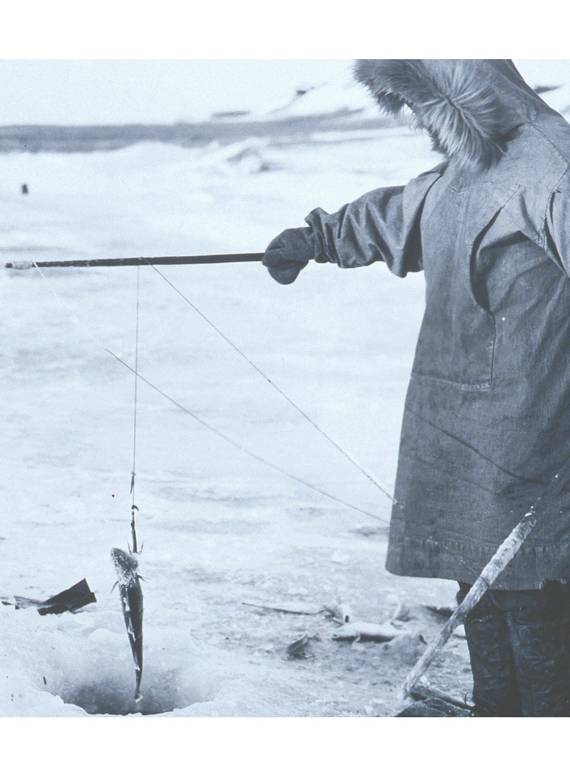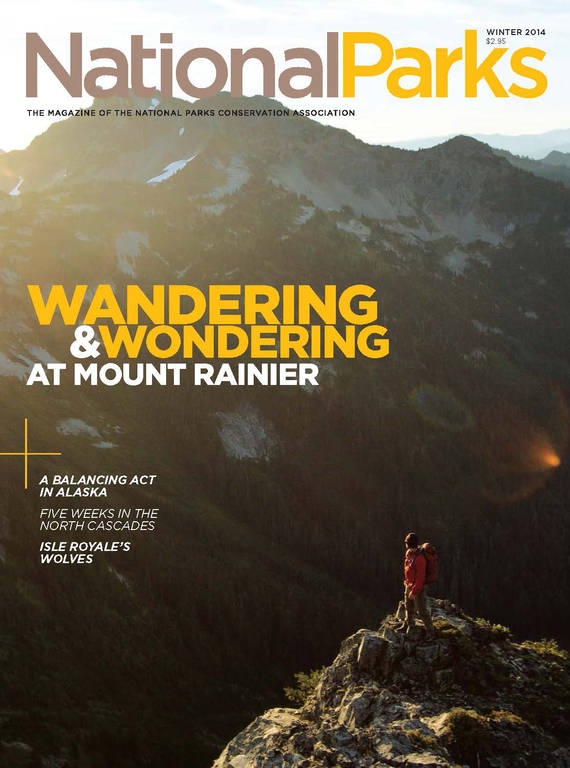Winter 2014
The Alaska Experiment
Three decades after President Carter added 47 million acres of Alaska to the National Park System, managing those lands remains a complex and highly political effort.
For countless millennia, the caribou herds of Northwest Alaska have migrated across the Brooks Range in fall, leaving their calving grounds in the Arctic tundra for sheltered valleys to the south. And for at least eight of those millennia, according to archaeological records, the caribou have been met along the way by Inupiat Eskimo hunters preparing for the long winter.

Historic image of ice fishing for tomcod.
© ALASKA STOCK IMAGES/NATIONAL GEOGRAPHIC CREATIVEIn recent years, though, the caribou stopped showing up with their usual reliability. The local Inupiat turned for help to an unlikely source—the National Park Service.
The apparent problem: Commercial outfitters based in Kotzebue were taking more and more urban hunters from Anchorage and the Lower 48 states to the mountains north of the traditional Eskimo villages.
The first caribou of fall, encountering this early-season fusillade as they came south, turned and headed for the hills, dispersing the herds away from the usual river crossings and hunting grounds.
In most of the United States, such a dispute between groups of hunters wouldn’t be the concern of national park rangers. Hunting is banned in most national parks.
But Alaska has been governed by special rules ever since 1980, when an act of Congress doubled the size of the National Park System while adding 104 million acres of new parks, preserves, and wildlife refuges in the 49th state. Under that law, Noatak National Preserve in Northwest Alaska is open to any hunter with a state license, with a priority given to local rural Alaskans hunting and fishing for subsistence, to meet important dietary and cultural needs in their communities. In 2012, after years of local complaints, the National Park Service finally asserted its jurisdiction, restricting commercial air taxis from delivering early-season urban hunters to the preserve. The move was controversial and will require further tinkering. But it worked. Migration patterns, and the fall subsistence hunts, went back to their old ways. Just as Congress intended.
Inhabited Wilderness
It has been more than three decades since Congress launched its huge experiment in managing what historian Theodore Catton has called “inhabited wilderness.” The Alaska National Interest Lands Conservation Act of 1980 (ANILCA) set out explicitly to preserve not only the land but, to a certain extent, the lives of the rural people living on that land. “It was that tension between the rights of native peoples to be masters of their own cultural evolution on the one hand, and the desires of preservationists to retain the primitive feeling of Alaska’s national parks on the other, which made the new parks so interesting and yet so fraught with difficulty,” Catton wrote in Inhabited Wilderness, an early history of the Alaska experiment.
So how has it worked out one generation later? To some extent, it depends where you plunk down your finger on Alaska’s map.
There have been examples of bureaucratic bungling by uptight or bullying federal officials, acts of violence and destruction by squirrely locals, and growing tension among Alaskans playing federal and state laws off each other in a contest for hunting and fishing access. National park superintendents have faced tough negotiations with state officials working under very different priorities. They have also faced tough negotiations with one another, as disputes arose between old Alaska hands and Park Service careerists, cycling north for a tour of duty, who saw local residents as a problem to be managed tightly.
But there have been happy successes as well. The passage of time has brought, perhaps surprisingly, a growing measure of affection for the parks in rural communities that once resisted the coming of uniformed rangers and the new rules they brought to the continent’s last wide-open country. Now, these communities sometimes look to the feds to defend rural subsistence lifestyles against urban sportsmen and their elected representatives, whose growing numbers have come to dominate modern Alaska politics.
The beneficiaries have been all rural Alaskans, not just Alaska Natives. Hundreds of miles south of the Noatak River, for example, in a corner of Denali National Park and Preserve, both settlers and local Ahtna Indians in the tiny highway town of Cantwell were granted the right to use all-terrain vehicles to haul moose meat out of several valleys over hardened trails. Anchorage hunters got no such advantage.
On everyday issues such as cutting firewood and house logs in the parks, managers have had to learn how to engage local communities creatively, rather than hand down edicts.
It hasn’t always worked. But today, under the leadership of Jon Jarvis, who learned the Alaska challenges first-hand in the 1990s as superintendent of Wrangell-St. Elias National Park, the National Park Service says it has embraced the new thinking.
“This isn’t about drawing a line and kicking everybody out,” says Sue Masica, director of the agency’s Alaska region since 2008. “These places were set aside because they have very special values and resources, and the people living here contribute to that.”
Far from being a one-time response to Alaska’s pioneer heritage and Native cultures, Masica says, this practice of engaging local communities has become part of the standard Park Service playbook for new and expanded parks since ANILCA—from the California desert of the 1980s to the present-day discussions involving the forests of northern Maine. Alaska veterans have also been invited abroad to advise other countries on setting up conservation plans that engage indigenous and rural communities.
“Why move to Alaska if not for the love of nature?” an innkeeper in the Wrangell Mountain ghost town of McCarthy wrote in Alaska’s newspapers a few years back, calling for more cooperation from the parks. “Who better to partner with than those who choose to live a wilderness lifestyle?”
A Grand Compromise
Today, the Alaska experiment may sound like part of a grand philosophical vision for conservation’s future. But it emerged in the 1970s from an improvised mix of compromise, back-to-nature romanticism, and political expedience.
To win the vote in Congress, environmentalists needed support from Alaska Natives, whose cultural connection to the land and its animals goes far beyond simply putting food on the table, especially in scores of roadless villages throughout the bush. Thus were born the important provisions protecting traditional subsistence hunting and fishing on federal conservation lands. But state leaders and Alaska’s congressional delegation resisted the idea of favoring Native people, so subsistence and other lifestyle protections were awarded to all rural Alaskans.
Some environmentalists and Park Service officials worried that the compromise had given away too much. Surely, they feared, as rural communities grew like towns had in the American West, pressures for local use would become incompatible with wilderness values. Thus far, though, Alaska’s bush communities, cold and remote, have experienced little of the growth recently seen in Alaska’s urban areas.
The new national parks are now widely accepted in Alaska’s business community as essential parts of the state’s tourist economy. But politicians led by Alaska’s powerful congressional delegation sometimes accused the Park Service of ignoring the compromises and imposing excessive restrictions as it implemented ANILCA. The challenges go beyond the opportunity to hunt but also include traveling to hunting grounds and gaining access across Park Service land to a resident’s home. Local landowners were often genuinely unable to figure out the rules to the new game—or cynically tried to write their own.
In one particularly high-profile case in Wrangell-St. Elias National Park, a charismatic and monstrous father of 15 led his clan in an escalating war with the park over his right to take a bulldozer down an overgrown washed-out wagon road that happened to be on park land. He said he just wanted access to the abandoned mine where his family lived. With his old-fashioned garb and Bible quotations, “Papa Pilgrim” became a poster boy for the property-rights movement—until he was imprisoned for violently abusing his family and relying on isolation to keep his secrets.
The final outcome was positive for the park: A federal court ruling clarified the government’s right to insist on environmental studies and regulatory permits before a bulldozer rumbles to life in a national park. The resolution also led in 2007 to a well-received and less draconian process to help landowners inside the park obtain legal access to their homes. Before the Pilgrim case, each park in Alaska approached the issue differently, which confused and frustrated residents.
Park rangers were sometimes derided as jack-booted thugs by the right and as spineless wimps by conservation groups. In the mid-1980s, an environmentalist lawsuit forced the government to shut down most of the last small gold mines still roiling creekbeds inside parks. In 2006, NPCA led several other groups in court to force the Park Service to curb off-road vehicles scarring the soggy tundra in the Wrangells. The final plan allows some recreational use over established trails in the area’s less-restrictive national preserve, while limiting use to rural subsistence inside the national park.
Joel Hard, the deputy regional director for the Park Service, was an Alaska State Trooper back in the early days of ANILCA, based at times along the Yukon River in the hot-headed village of Eagle. Local resistance to the Park Service was strong, from bull-dozer operator and bush hippie alike, as captured in John McPhee’s memorable book about those days in Alaska, Coming into the Country. Today, that bitterness is mostly gone, Hard says. In Yukon-Charley Rivers National Preserve, back-to-the-land pressures have faded, some of the most disgruntled residents have moved on, and federal rangers have tried to keep their presence low-key.
At least that was the case until 2010, when a law enforcement showdown in Yukon-Charley blazed headlines and revived decades-old resistance from the state of Alaska to federal authority.
The face-off involved two seasonal park rangers in a patrol boat who forced a 71-year-old local man to the shore at gunpoint on the Yukon and wrestled him into handcuffs because he refused to stop his skiff and submit to a safety inspection. Privately, park officials regretted the incident; the rangers involved were moved to assignments elsewhere. But state lawyers jumped in to support the boater, and the case morphed from a magistrate’s misdemeanor into a full-blown district court challenge of federal jurisdiction where the river passes through the preserve.
“We are all one misstep away from having an aggravating circumstance, and politicians are ready to jump in and take advantage and hold fundraisers,” says Hard. “In this case, antagonists were eager to pour gasoline on it.”
State vs. Feds
Although the Alaska experiment appears to be working for many people living in or near the parks, the state is still fighting much of the federal government’s basic authority to manage its lands. By far the most flammable state-federal conflict under ANILCA has been over hunting and fishing and related issues of managing game. Indeed it must be conceded that “subsistence” is turning into Alaska’s Hundred Year War, with no end in sight.
When Congress created its subsistence priority for rural Alaskans in 1980, everyone assumed the state would follow suit and legislate its own rural priority. Hunting and fishing would be managed jointly and cooperatively. It worked for a while, but in 1989 the Alaska Supreme Court threw out the state’s new subsistence law, saying the state constitution reserved fish and game for all residents equally, without discrimination by zip code. Several efforts since to draft a constitutional amendment that would allow a rural preference have been blocked by urban legislators, despite polls showing continued statewide support for the idea.
This left the federal government as the only defenders of rural subsistence, at least on national parks and refuges created by ANILCA. But the feds had to be bludgeoned into taking leadership on this issue, through a series of federal court decisions won by Indian rights lawyers.
The result today, in the highly politicized rod-and-gun world of Alaska, is a jury-rigged system known as “dual management.” The map of Alaska is now a patchwork of state and federal jurisdictions. State hunting laws apply on federal lands—except where they conflict with subsistence, at which point the feds step in. The result is a system that grows more Byzantine not only for hunters and fishermen but for the bureaucrats charged with explaining the laws.
It hasn’t helped that state-federal relations have gotten testier in the past decade, soured by the nation’s cultural and political divisions. Today’s governor, Sean Parnell, has been especially busy resurrecting retro-1970s fed-bashing as a northern hinterland variety of anti-Obama Republicanism.
One of the sharpest conflicts between the state and federal governments involves the state’s ongoing efforts to kill off predators, mainly wolves and bears, to increase numbers of moose and other game. This involves aerial hunting, expanded trapping seasons, and authorization to use bait stations for bears and spotlights in dens. In the national preserves, where jurisdictions overlap, the Park Service has to come up with special rules every year to forbid these practices, saying the parks are meant to be managed as ecosystems, not game farms. But the predator programs continue right outside park boundaries, which, some suspect, is why fewer wolves are being seen along the Denali National Park road.
The state’s effort to sell predator control as a pro-subsistence strategy, beneficial to rural as well as urban hunters, suggests there may be limits to how far even the most sympathetic park official can go to accommodate the lingering pioneer lifestyle of Alaska.
“You walk through a gate in the Lower 48 and every use of the park is regulated. The people who framed ANILCA decided not to do that,” says deputy regional director Hard. The challenge for the parks, he says, is to make sure that those who live in the continent’s last great wilderness exercise that freedom without altering the fundamental wildness of the land.
About the author
-
 Tom Kizzia Contributor
Tom Kizzia ContributorTom Kizzia tells the story of Papa Pilgrim in his new book, Pilgrim’s Wilderness. A longtime reporter for the Anchorage Daily News, he has written about Alaska conservation issues for 35 years.



